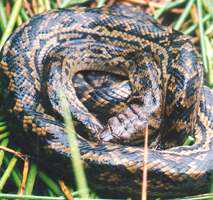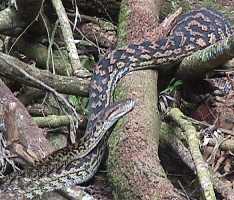Amethystine Python

Photo: Courtesy of Damon Ramsey
BSc.(Zool) Biologist GuideAmethystine Python (Morelia amethistina) - As one of the ‘giant’ snakes, it has been recorded at a length of up to 8.5 metres (28 ft), found near Gordonvale, but are more frequently found at lengths of 3-5m (10-16 ft).
- It acquires its name from the fact that when viewed from certain angles in direct sunlight, it displays an Amethyst coloured shine all over its body.
- It is a slender python for its size and is not able to kill large animals that the related Anaconda of South America and the Pythons of Africa and Asia can.
Markings: - It has a series of pits along its jaw which are very heat sensitive organs. This enables the snake to locate its warm-blooded prey.
- This snake can be differentiated from the Carpet Python by the fact that is has a lesser number of large tortoise-like platelets on its head.
- Spurs at each side of the anus in pythons are the remains of legs, indicating the evolutionary link of all snakes with a lizard-like ancestry. (Source: Environmental Protection Agency)
- Greeny-brown in colour but the scales have a blue-purple (Amethst) irridescence (hence, their name).
Habitat: - These include the wetter tropical rainforests, monsoon forests and vine forests.
Breeding: - Female can lay up to 20 eggs at a time, once a year
- eggs are incubated for 2 months, as snakes are cool blooded, she warms the eggs by coiling around them and shivering, generating body heat.
- Hatchlings feed on small mammals.
Hunting: - There is no record of Amethystine Pythons being a danger to human beings and will do everything possible to avoid human contact.
- When small animals come within striking distance, the python seizes its prey with its gaping mouth, and throws coils of its body around the prey which constricts and suffocates the animal. The coiling of the snake around its prey also prevents the animals from moving and potentially inflicting harm upon the snake. This is done because pythons do not posses any poison glands.
- Night time gives pythons a distinct advantage. Apart from smell, they rely on heat-sensing organs below their jaws to detect warmth radiating from bird and mammal prey. During the day, ground heated by the sun confuses this heat-picture, but at night, when the surroundings are cool, a potential warm dinner stands out. (Source: Department of Environment)

Chambers' resident Amethystine Python sunning itself on the log piles.
Note the Large bulge in it's stomach (probably a Pademelon) Diet: - A pythons prey includes fruit bats, possums, rats, pademelons and ground dwelling birds.
Viewing Opportunities: - During your stay at The Chamber's, the best viewing situation for Amethystine Pythons is the 10:15am wildlife cruise on Lake Barrine.
- During winter they can sometimes be seen sunning themselves on log piles at The Chamber's.
- If you have a keen interest in viewing them, please let John Chambers know and he will advise you of any sightings during your stay.
- Sometimes can be seen on the top road when driving home at night.
Additional Information: Amethystine Python: Morelia amethystina The ‘Amethystine Python’ or 'Scrub Python' is Australia's biggest snake. They are usually found in or near tropical rainforest and are generally nocturnal and aboreal, although they can be seen sunning themselves during the day (above). They have been known to swallow bandicoots and rainforest wallabies. They are sometimes seen on the Daintree River.
Script: Courtesy of Damon Ramsey BSc.(Zool) Biologist Guide Pythons: Family Pythonidae Pythons are mainly found in the Old World tropics and subtropics, including Africa, Asia and Australia. They are best developed in Australia (Shine 1998) where they are found from the rainforest, to the woodland, to the desert, and range in size from the Amethystine Python, one of the world's top five biggest snakes to the tiny 60 centimetres `Pygmy Python' Antaresia perthensis (Shine 1998). Pythons have a very interesting reproductive cycle that sets them apart from the related Boas. First, they lay eggs. Then the mother curls around these eggs and incubates them with it's own body heat. Of course, being ectothermic, pythons do not have a naturally occurring high body temperature, thus they have to produce this. This is done by gathering it from the sun by basking, or by a process known as shivering thermogeneisis. Essentially, the python vibrates it's body with it's muscles, in effect it is shivering to provide warmth for the eggs to develop (Shine 1998). During this time the mother does not eat, uses up much energy and may loose up to half her own body weight and be another few years until she is sufficiently recovered to mate again (Shine 1998). After the eggs hatch, the parent no longer looks after them (Shine 1998)
Script: Courtesy of Damon Ramsey BSc.(Zool) Biologist Guide Additional Amethystine Python Photos Additional Amethystine Python Photos 2 |
